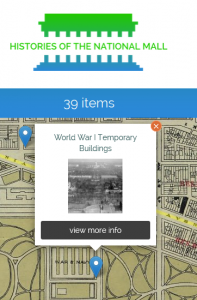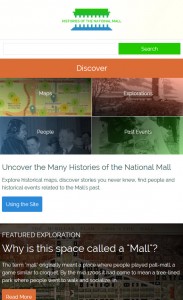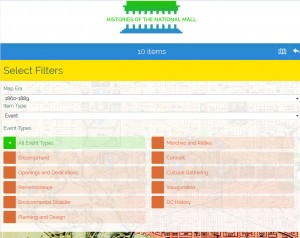Outstanding public history project award: Histories of the National Mall
18 March 2015 – Sheila Brennan
Editor’s Note: This series showcases the winners of the National Council on Public History’s awards for the best new work in the field. Today’s post is by Sheila Brennan, project co-director with Sharon Leon of the Roy Rosenzweig Center for History and New Media’s Histories of the National Mall mobile website.
Every year, nearly 25 million people visit the National Mall and wander from monument to museum vaguely aware of the rich history of the space. Histories of the National Mall is a place-based public history mobile website designed to allow visitors to access that history while on the Mall itself. Created primarily for tourists and a secondary audience of history enthusiasts not physically in Washington, DC, Histories is accessible from any web browser on any phone, tablet, laptop, or desktop. The Roy Rosenzweig Center for History and New Media (RRCHNM) at George Mason University developed this site with support from a grant in 2012 from the National Endowment for the Humanities.
The National Mall has a history of its own that is nearly invisible when walking its paths, and there is very little interpretation available on the Mall. Most visitors see what appears to be a finished product: a deliberately planned landscape with memorials, monuments, and museums symbolizing the history and values of the United States. The Mall, however, is a contested public space and its meanings, uses, and purposes have changed over time. In its earliest days, the Mall was a messy place where transportation arteries and commercial markets existed and was bordered by lively neighborhoods. Visitors, and many DC area residents, have no knowledge of the unregulated zone of muddy grounds, vegetable gardens, grazing cattle, or the slave pens that existed before the completion of the Washington and Lincoln Memorials.
Our key strategy for making the history of the National Mall engaging for tourists was to populate the website with surprising and compelling stories and primary sources that together build a textured historical context for the space and how it has changed over time. Drawing on the extensive range of primary sources available at DC cultural heritage institutions, we assembled a rich documentary record of the many historical facets of the National Mall. Then, we added a layer of rigorous historical interpretation to those sources, synthesizing the most recent public history scholarship, raising provocative questions about the space, its role in national life, and the expressions of American ideals that have taken place there–questions that have engaged scholars for decades. Importantly, Histories uses the Mall to connect the development of Washington as a residential city with its role as the nation’s capital. For users interested in digging deeper into the secondary material, we created a public Zotero library and link to it from the Project Development page in the About section.
User Experience
The mobile-optimized website allows users to engage in a self-guided exploration of over 440 items, including people, sites, past events, and primary sources, with 40 inquiry-based explorations. We created four different entry points that are place-based, thematic, chronological, and biographical, connecting the physical space and its development, together with the social, cultural, and political events that have transpired there.
-
Maps offer a wayfaring guide to today’s Mall and eight historical maps that depict the Mall’s features and environment at different points in time. Historical events and sources appear as pins on the maps. Choosing a historical map layer then reveals to users events and sources from that time period located near them.
-
Explorations are short episodes about the Mall’s history that begin with a leading question, such as: Were slaves bought and sold on the Mall? How have protests on the Mall changed over time? Why is there a lockkeeper’s house on the Mall? Each question is answered with historical sources from DC area libraries, archives, and museums. Users may browse by question or theme (including politics & protest, design & monuments, work & play, commerce & trade, and ghost Mall).
-
Past Events offer users a chronology of significant Mall-related events, grouped in eras of roughly 30 years. Users may jump to time periods that interest them or scroll chronologically from the pre-1800s to the present.
-
People provides short biographies of individuals who shaped the Mall’s past and present. These elements highlight the contributions of lesser-known individuals whose impact would be impossible to find anywhere on the Mall itself.
Design and Outreach
Histories runs on the Omeka open-source platform developed by RRCHNM, using a custom responsive design theme. We built a custom map layering plugin that uses the leaflet.js libraries for tiling and serving historical map layers that works together with Omeka’s Geolocation plugin. We created the Explorations using the Exhibit Builder and the About sections with Simple Pages. The Simple Vocab and Search by Metadata plugins allowed us to create controlled vocabulary for linking items through metadata fields, such as eras, event types, and occupations. Our decision to design for the mobile web, and not develop an app, is tied directly to our goal of reaching the largest percentage of visitors to the Mall over the long term. Histories of the National Mall is not constrained by the quickly evolving world of mobile application development protocols, making the project easy to maintain after the grant period ends. Importantly, this means the content is accessible to the broadest audience of users and mobile devices, including international visitors who can use the free wifi available on the Mall and in the Smithsonian museums. This approach makes the content more discoverable because it is indexed by major search engines. We have noticed that local journalists use Histories for their research, and links to the content have appeared on Politico,Curbed DC, as well as on individual blogs interested in special topics.
An active and on-going outreach plan is central to our efforts in attracting visitors to Histories. Colorful brochures containing the site URL and a QR code are available at DC visitor centers, including the White House Visitor Center and Walter E. Washington Convention Center, as well as at the Historical Society of Washington, DC, and Martin Luther King, Jr. Memorial Library. We hosted a scavenger hunt and a MeetUp to interest local residents and digital cultural heritage professionals in the project. Also, we regularly share content from Histories on Facebook, tumblr, and Twitter, which is often shared and recirculated by cultural institutions located on the Mall. The social media strategy has cultivated a following of return visitors to the site. These combined outreach efforts contribute to a steady increase in site traffic each month.
The results of our design and outreach decisions suggest Histories of the National Mall has struck the right balance between the accessibility of the mobile-first design and the engaging historical content and interpretation. Woven together, these elements create a digital public history project that will enrich the experience of the Mall’s visitors in years to come. RRCHNM plans to continue adding content and to continue our outreach efforts beyond the grant period, which ends officially in the summer of 2015.
~ Sheila A. Brennan is Co-Director of Histories of the National Mall, and Associate Director of Public Projects and Associate Research Professor at the Roy Rosenzweig Center for History and New Media, George Mason University






